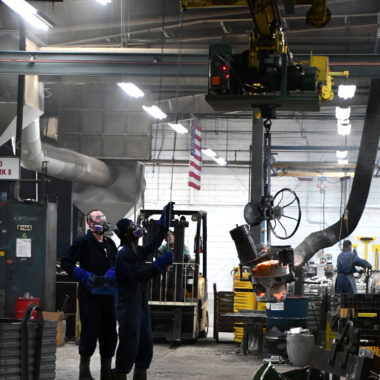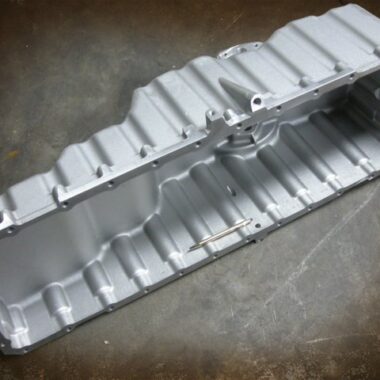Precision in Practice: The Art About Aluminum Casting
Precision in Practice: The Art About Aluminum Casting
Blog Article
Crafting Perfection: How to Achieve High-Quality Light Weight Aluminum Castings Whenever
In the world of aluminum casting, the pursuit of excellence is a constant trip that requires a precise technique and a keen understanding of the details entailed. Achieving consistent high-grade light weight aluminum spreadings demands a comprehensive grasp of the procedures, from selecting the ideal alloy to implementing exact mold designs and meticulously controlling casting specifications.
Understanding Light Weight Aluminum Spreading Processes
Aluminum casting processes, necessary in the production sector, entail the complex improvement of molten light weight aluminum right into solid forms via a collection of very carefully controlled steps. Understanding these procedures is critical to accomplishing top notch light weight aluminum spreadings constantly - about aluminum casting. The key methods used in light weight aluminum spreading are pass away spreading, sand casting, and investment spreading

Each of these procedures has its advantages and is selected based upon aspects like complexity, volume, and desired coating of the light weight aluminum casting. about aluminum casting. Understanding the intricacies of these approaches is essential for manufacturers intending to create high-grade light weight aluminum castings regularly
Picking the Right Aluminum Alloy
Picking the appropriate aluminum alloy is an essential choice in the production of top quality light weight aluminum castings. The option of alloy significantly affects the homes and characteristics of the end product. Different aluminum alloys supply differing levels of toughness, corrosion resistance, machinability, and thermal conductivity. When picking an aluminum alloy for casting, it is vital to consider the certain demands of the application to guarantee ideal performance.
One of the most frequently utilized light weight aluminum alloys for spreading is A356 - about aluminum casting. For applications needing high toughness, 7075 light weight aluminum alloy is a preferred option due to its extraordinary strength-to-weight proportion.
In enhancement to mechanical homes, considerations such as price, availability, and post-casting processes must also affect the option of the best aluminum alloy. By very carefully reviewing these aspects, manufacturers can ensure the production of top quality aluminum castings that fulfill the wanted requirements.
Executing Appropriate Mold Style
Developing an efficient mold and mildew design is vital for ensuring the successful manufacturing of top quality light weight aluminum spreadings. Proper mold design plays a considerable role in accomplishing the wanted features of the end product. To execute a successful mold style, variables such as material circulation, cooling down prices, and part geometry must be thoroughly considered.
One key aspect of mold design is guaranteeing correct dental filling and solidification of the aluminum within the mold and mildew tooth cavity. This involves developing runner and gating systems that facilitate smooth metal flow and stop defects such as air entrapment or incomplete filling. In addition, integrating cooling networks right into the mold and mildew style helps manage solidification rates and reduce the threat of porosity or contraction flaws.

Controlling Spreading Parameters

Ensuring Post-Casting Top Quality Checks
To maintain the high quality of light weight aluminum spreadings, detailed post-casting high quality checks are crucial. After the spreading procedure is completed, it is critical to make certain that the final products meet the preferred requirements and standards.
Dimensional precision is another essential aspect that should be confirmed throughout post-casting high quality checks. Measurements of vital measurements and resistances need to be required to validate that the castings adjust to the called for requirements. In addition, mechanical homes such as firmness, tensile toughness, and influence resistance might require to be examined via material screening to make certain that the spreadings have the needed strength and longevity for their desired application.
Verdict
In final thought, accomplishing premium light weight aluminum castings needs a thorough understanding of the spreading procedures, choosing the suitable alloy, designing mold and Recommended Reading mildews properly, managing casting specifications carefully, and carrying out post-casting top quality checks faithfully. By complying with these actions, manufacturers can consistently generate aluminum castings that satisfy the highest criteria of high quality and performance.
Accomplishing regular premium light weight aluminum spreadings demands a comprehensive understanding of the procedures, from choosing the appropriate alloy to carrying out exact mold and mildew designs and diligently regulating casting parameters. The main techniques made use of in aluminum spreading are our website pass away casting, sand spreading, and investment casting.
Financial investment casting, additionally known as accuracy casting, includes creating wax patterns that are coated in ceramic to create molds.Choosing the appropriate light weight aluminum alloy is an important decision in the production of high-grade light weight aluminum castings.Making certain accurate control over spreading criteria is vital for keeping consistency and high quality in light weight aluminum spreading production.
Report this page